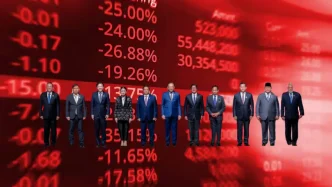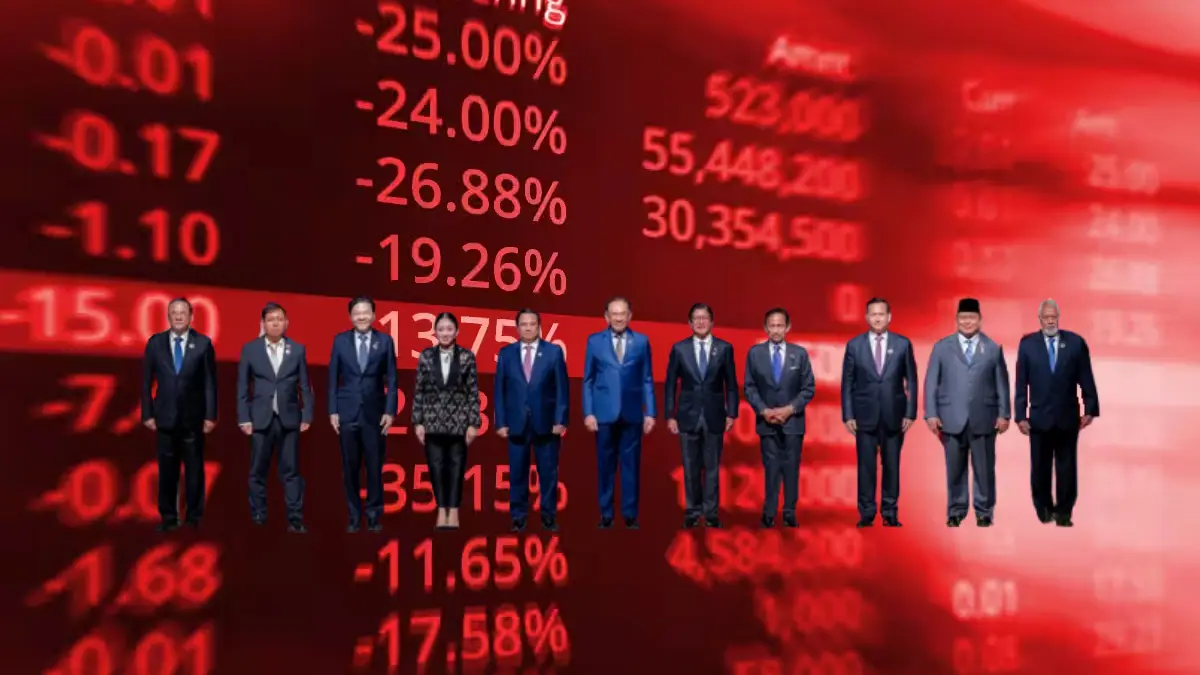As the clock ticks toward an August 1 deadline, a wave of uncertainty has gripped Asia’s economies following US President Donald Trump’s announcement of steep tariffs on imports from multiple countries. The tariffs, ranging from 25% to 40% across nations like Japan, South Korea, Malaysia, Indonesia, Thailand, and others, threaten to disrupt trade flows, inflate consumer prices, and slow economic growth across the region. With negotiations ongoing and the White House’s stance unpredictable, businesses and governments are bracing for a challenging period ahead.
Trump’s Tariff Gambit: A Regional Shockwave
On July 7, 2025, President Trump sent formal letters to several Asian nations, outlining punitive tariffs on their exports to the US, set to take effect on August 1. Japan and South Korea, key US allies, face a 25% tariff on their goods, while South-east Asian nations received varied rates: Malaysia at 25%, Indonesia at 32%, Thailand at 36%, and both Laos and Myanmar at 40%. Cambodia saw a surprising reduction to 36% from an earlier proposed 49%, though no explanation for the adjustment was provided. Sector-specific tariffs, including 25% on automobiles and 50% on steel and aluminum, will further strain manufacturing powerhouses like Japan and South Korea.
The letters, posted on Truth Social late on July 7, also hinted at additional penalties for goods transshipped from China through other countries to evade higher tariffs, though specific rates were not disclosed. Trump’s message was clear: nations have just three weeks to negotiate a deal or face the consequences. The White House also warned that any retaliatory tariffs from affected countries would be met with equivalent measures from the US, escalating the risk of a broader trade war.
While Trump acknowledged the strength of trade relationships in his communications, he expressed frustration over persistent US trade deficits with these nations. His erratic negotiation tactics, however, have raised questions about the credibility of the August 1 deadline. As William Alan Reinsch, an expert in economics and international business at the Center for Strategic and International Studies (CSIS), noted, this approach seems like a familiar playbook: “Clarify the threat, extend the deadline, and hope that leads to a deal.”
Economic Ripples: Higher Prices and Slowing Growth
The potential impact of these tariffs is profound, particularly for export-driven economies in Asia. For Japan and South Korea, a 25% tariff on key exports like automobiles and semiconductors could significantly dent their economic output. Reinsch warned that such measures “will mean higher prices here [in the US] and a slowdown in the economies of the other two countries.” The ongoing Section 232 investigations, which could lead to additional tariffs on these sectors, add another layer of uncertainty.
In South-east Asia, the varied tariff rates reflect a patchwork of economic pressures. Thailand, facing a 36% tariff, could see its export industries—ranging from electronics to agriculture—struggle to remain competitive in the US market. Malaysia, with a slightly lower rate of 25%, is still anticipating a slowdown in domestic demand, prompting speculation that its central bank may cut interest rates to 2.75% at its upcoming policy meeting on July 9, according to a recent HSBC report.
Indonesia, hit with a 32% tariff, and Cambodia, with a reduced but still hefty 36%, are also preparing for economic headwinds. For smaller economies like Laos and Myanmar, both facing 40% tariffs, the impact could be even more severe, potentially exacerbating existing challenges such as political instability and limited industrial capacity. Meanwhile, countries like Singapore, India, and Taiwan await their fate, as no letters have yet been received from the White House.
Businesses on Edge: A Supply Chain Under Strain
Across the region, businesses are feeling the strain of uncertainty. In Taiwan, which has yet to receive formal notification but faces a looming 32% tariff threat, Bai Tsan-jung, chairman of Sun Jen Textile Company, described the situation as “the most stressful and challenging period” in his firm’s 40-year history. Speaking to a regional news outlet, he revealed that nearly half of his 110-member workforce could face furloughs or early retirement if Taipei fails to secure a deal by the July 9 negotiation deadline. “A steep US tax on our goods could be the final blow for us,” he said, highlighting how tariffs affect not just direct exporters but entire supply chains, as his company supplies garment factories in Taiwan, Indonesia, and Vietnam that export to the US.
Similarly, Bruce Chang, sales manager at TopTowel, a Taiwanese manufacturer of towels for sportswear and lifestyle brands, is scrambling to diversify markets. With the US accounting for 18% of the firm’s exports, Chang is currently in Japan seeking new clients in regions like Australia and Europe. “The huge uncertainty over the US tariffs means that we need to look at opening up new markets,” he explained over a phone interview with a local publication.
Taipei has responded by pledging to prevent Chinese goods from being relabeled as “Made in Taiwan” to dodge US tariffs and committing to purchase more American products, such as natural gas, to narrow its trade deficit with the US. Yet, for many businesses, these government assurances offer little immediate relief.
Negotiations and Deals: A Race Against Time
As the deadline approaches, negotiations between the US and affected nations are intensifying. Vietnam appears to have gained an edge, having struck a deal on July 2 that allows American goods to enter duty-free while reducing US tariffs on Vietnamese exports to 20% from an earlier proposed 46%. Goods transshipped through Vietnam from other nations, such as China, will face a higher 40% tariff under the agreement, though details are still being finalized.
India, yet to receive a formal tariff notification, is reportedly exploring a “mini” trade deal with the US. Negotiations focus on opening segments of its agriculture and dairy sectors while seeking reduced tariffs on textiles, footwear, auto parts, aluminum, and steel—potentially below the 26% rate floated earlier. However, India remains resistant to US demands for exports of genetically modified crops like corn, wary of domestic political backlash from its influential farm lobby. Industry insiders note that India is eyeing Vietnam’s 20% tariff rate as a benchmark, with one source stating, “It’s no longer just about tariffs anymore, it’s about comparative tariffs.”
China, already burdened by separate tariffs linked to issues like fentanyl smuggling and alleged unfair trade practices, reached a trade truce with the US in late June. However, specifics remain undisclosed, and Washington has expressed frustration over slow progress on China’s commitments, particularly regarding rare earth exports crucial to the tech industry.
Allies in the Crosshairs: A Strategic Misstep?
The decision to impose 25% tariffs on close allies like Japan and South Korea has drawn sharp criticism from trade experts. Wendy Cutler, a former US trade negotiator and current vice-president at the Asia Society Policy Institute (ASPI), called the move “unfortunate,” emphasizing the deep economic ties between the US and these nations. “Both have been close partners on economic security matters and have a lot to offer the US on priority matters like shipbuilding, semiconductors, critical minerals, and energy cooperation,” she said. Cutler noted that companies from both countries have invested heavily in US manufacturing, creating high-paying jobs and serving as key markets for American goods ranging from pork to aircraft.
Despite the grim outlook, Cutler remains cautiously optimistic, suggesting that a breakthrough in negotiations before August 1 is still possible. “While the news is disappointing, it does not mean the game is over,” she added. However, her comments also underscored a chilling message from the US: reprieves from sectoral tariffs, particularly on automobiles—a priority for Japan and South Korea—are unlikely.
Looking Ahead: An Uncertain Future
As Asia’s governments and businesses scramble to respond, the broader implications of Trump’s tariff strategy remain unclear. Will the August 1 deadline hold, or will it shift again as negotiations drag on? Reinsch poses a critical question: “As August 1 approaches and there are still no deals, will Trump extend the deadline again—and perhaps increase the tariffs—or will he actually impose them?”
For now, the region faces a trifecta of challenges: slowing economic growth, rising consumer prices, and potential job losses. Market volatility is almost certain as businesses reevaluate supply chains and governments weigh the risks of retaliation. In Kuala Lumpur, analysts predict a negative impact on Malaysia’s domestic economy regardless of the outcome of trade talks, while in Taipei, small and medium enterprises like Sun Jen Textile Company teeter on the brink.
The coming weeks will test the resilience of Asia’s economies and the diplomatic prowess of its leaders. As negotiators haggle over clauses and concessions, the specter of a trade war looms large, with ripple effects that could reshape global economic dynamics for years to come. Whether a last-minute deal can avert disaster remains an open question, one that businesses and citizens across the region are watching with bated breath.















